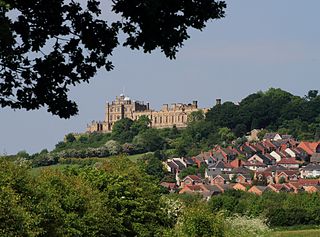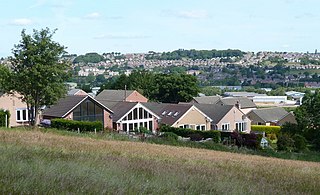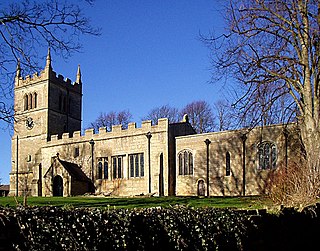
Bolsover is a market town and the administrative centre of the Bolsover District, Derbyshire, England. It is 145 miles (233 km) from London, 18 miles (29 km) from Sheffield, 26 miles (42 km) from Nottingham and 27 miles (43 km) from Derby. It is the main town in the Bolsover district.

North East Derbyshire is a local government district in Derbyshire, England. It borders the districts of Chesterfield, Bolsover, Amber Valley and Derbyshire Dales in Derbyshire, and Sheffield and Rotherham in South Yorkshire. The population of the district as taken at the 2011 Census was 99,023. The district council is a non-constituent partner member of the Sheffield City Region Combined Authority. The district is a non-constituent member of the Sheffield City Region and shares a membership along with neighbouring Derbyshire Dales, Borough of Chesterfield, Bolsover District and Bassetlaw District in Nottinghamshire. The district is also part of The Derby, Derbyshire, Nottingham and Nottinghamshire Local Enterprise Partnership.

Darley Dale, also known simply as Darley, is a town and civil parish in the Derbyshire Dales district of Derbyshire, England, with a population of around 6,000. It lies north of Matlock, on the River Derwent and the A6 road. The town forms part of the urban area of Matlock and acts as a commuter town for workers there.

Bolsover District is a local government district in Derbyshire, England. It is named after the town of Bolsover, which is near the geographic centre of the district, but the council is based in Clowne. At the 2011 Census, the district had a population of 75,866. The district is along with North East Derbyshire, Borough of Chesterfield and Bassetlaw District is a non-constituent member of the Sheffield City Region.

Whitwell is a village in Derbyshire, England. The population of the civil parish taken at the 2011 Census was 3,900.

Hayfield is a village and civil parish in High Peak, Derbyshire, England, with a population of around 2,700. The village is 3 miles (4.8 km) east of New Mills, 4.5 miles (7.2 km) south of Glossop and 10 miles (16 km) north of Buxton, in the basin of the River Sett.
Ellastone is a rural village in the West Midlands of England on the Staffordshire side of the River Dove, between Uttoxeter and Ashbourne in north Staffordshire.

Blackwell is a village in Derbyshire, England. The population of the civil parish as of the 2011 census was 4,389. It is one of the four villages that make up the civil parish of Blackwell within the District of Bolsover - the other villages being Hilcote, Newton and Westhouses. The Parish Council meets monthly. A brief history of the Parish of Blackwell was published in 1994.

Clowne is a town and civil parish in the Bolsover district of Derbyshire, England. The population at the 2001 Census was 7,447 increasing to 7,590 at the 2011 Census. It forms part of the Bolsover constituency. Clowne lies 9 miles (14 km) north east of Chesterfield and 7 miles (11 km) south west of Worksop. It is mentioned in the Domesday Book as Clune. The name is derived from the Celtic Clun for a river.

Creswell Model Village is an arts and crafts style model village in the village of Creswell, Derbyshire, England. The pit village was built in 1895 by the Bolsover Colliery Company to designs by architect Percy B. Houfton for the workers of Creswell Colliery on land leased from the Welbeck Estate. Influenced by garden village principles, it provided the workers with modern facilities; it had a tramway to deliver coal to the houses. Designed around a large oval village green with an access road through the centre, the houses are of varying styles. The Model as it is known, has been refurbished.

Creswell is a former mining village located in the Bolsover district of Derbyshire, England. At the 2011 Census population details were included in the civil parish of Elmton-with-Creswell. Today it is best known for Creswell Crags and its model village. In September 1950 Creswell Colliery was the scene of one of the worst post-nationalisation mining disasters. Elmton Common is an area of allotments for the township of Creswell.

Brimington is a large village and civil parish in the Borough of Chesterfield in Derbyshire, England. The population of the parish taken at the 2011 census was 8,788. The town of Staveley is to the east, and Hollingwood is nearby. The parish includes Brimington Common along the Calow Road, and New Brimington, a late 19th-century extension towards the Staveley Iron Works.

Belph is a hamlet in the parish of Hodthorpe and Belph, within the district of Bolsover, in the county of Derbyshire, England. It is part of the Welbeck Abbey Estate, on the edge of modern-day Sherwood Forest. The village is 1 mile (1.6 km) south-east of Hodthorpe, 1 mile (1.6 km) south-east of Whitwell and 3 miles (4.8 km) south-west of Worksop. The village is the easternmost settlement in Derbyshire.

Scarcliffe is a village and civil parish in the Bolsover district of Derbyshire, England. It is sometimes called Scarcliffe with Palterton. The population of the parish at the 2001 UK Census was 5,211, increasing to 5,288 at the 2011 Census.

Langwith is a close group of six villages crossing the Derbyshire-Nottinghamshire border, on the River Poulter about 2 miles (3.2 km) from Warsop, and about 4 miles (6.4 km) from Bolsover on the A632 road, south of Whaley Thorns. The population is listed under the Nottinghamshire civil parish of Nether Langwith.

Whaley Thorns is a former colliery village in the Bolsover district of Derbyshire, England, close to the Nottinghamshire border. Whaley Thorns lies just north of Nether Langwith and Langwith, 1.5 miles (2.4 km) south-east of Creswell, and west of Cuckney. It is in the civil parish of Scarcliffe.
Old Bolsover Town Council is the parish council for the civil parish of Old Bolsover in Derbyshire, England. It has responsibility for local issues in the town of Bolsover, including setting an annual precept to cover the council's operating costs and producing annual accounts for public scrutiny. The town council evaluates local planning applications and works with the local police, district council officers, and neighbourhood watch groups on matters of crime, security, and traffic. The town council's role also includes initiating projects for the maintenance and repair of parish facilities, as well as consulting with the district council on the maintenance, repair, and improvement of highways, drainage, footpaths, public transport, and street cleaning. Conservation matters and environmental issues are also the responsibility of the council.

Hodthorpe and Belph is a civil parish within the Bolsover district, of the county of Derbyshire, England. The parish includes the village of Hodthorpe and the hamlet of Belph. In 2011 the parish had a population of 663. It is 132 miles north west of London, 27 miles north east of the county city of Derby, and 5 miles north east of the market town of Bolsover. The parish touches Welbeck, Whitwell, Elmton with Creswell and Holbeck, and is the easternmost in Derbyshire. There is one listed building in Hodthorpe and Belph.
















